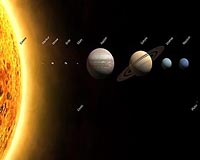 |
Denver CO (SPX) Mar 22, 2011 Forging a new path forward to ensure safe, affordable and sustainable human exploration beyond low Earth orbit, Lockheed Martin has unveiled the first Orion spacecraft and a spacious state-of-the-art Space Operations Simulation Center (SOSC). These two major projects, located at Lockheed Martin's Waterton Facility near Denver, Colo., showcase the NASA-industry teams' progress for human space flight, the Orion Project and NASA's Multi-Purpose Crew Vehicle. The spacecraft will undergo rigorous testing in Denver to validate Orion's ability to endure the harsh environments of deep space. The Orion crew exploration vehicle is on schedule to conduct its first orbital flight test as early as 2013 and provide initial operational flights by 2016 as required by the NASA Authorization Act of 2010. "Our nation's next bold step in exploration could begin by 2016," said John Karas, vice president and general manager for Lockheed Martin's Human Space Flight programs. "Orion was designed from inception to fly multiple, deep-space missions. The spacecraft is an incredibly robust, technically advanced vehicle capable of safely transporting humans to asteroids, Lagrange Points and other deep space destinations that will put us on an affordable and sustainable path to Mars." The SOSC represents part of Lockheed Martin's multi-million dollar investment in testing and validating future human spaceflight programs to ensure safe, affordable and sustainable space exploration. The demonstrations at the SOSC featured simulated missions to an asteroid and the International Space Station using laser and optically guided robotic navigation systems. This system and other cutting edge capabilities demonstrate how Lockheed Martin employs full-scale motion to test and verify multiple mission scenarios. The SOSC currently supports integrated testing of Orion's Relative Navigation System, which includes STORRM (Sensor Test for Orion RelNav Risk Mitigation) - a new and innovative navigation and docking system that will be tested on the upcoming STS-134 shuttle mission to the International Space Station. STORRM is one of the major subsystem tests that will be completed before Orion's first orbital flight test in 2013, that will conduct high-altitude orbits and a high-energy reentry that simulate the environments of a deep space mission. SOSC operations support critical development, evaluation and testing necessary to ensure safe, successful human and robotic missions to Earth-orbiting platforms, planets, moons or other bodies in our solar system. In addition, the center tests ranging, rendezvous, docking, proximity operations, imaging, descent and landing systems. "Lockheed Martin built this remarkable facility to develop and test spacecraft systems, further demonstrating our commitment to improve safety and advance capabilities for future U.S. human spaceflight," said Karas. "Our collective expertise in systems integration, planetary exploration and human spaceflight operations will help ensure success for our nation's next generation space transportation system." The SOSC is built upon a 1,700-foot-deep Colorado bedrock formation and is isolated from local seismic disturbances. This foundation provides an ultra-stable environment for testing precision instruments and accurate navigation systems needed for space vehicles. The 41,000-square-foot facility also holds a Leadership in Energy and Environment Design (LEED) Gold rating for its high efficiency environmental controls, energy-saving lighting systems, and native vegetation landscaping. Lockheed Martin is the prime contractor to NASA for Orion, a multipurpose exploration spacecraft capable of exploring destinations throughout our solar system. The Orion spacecraft comprises a crew module for crew and cargo transport; a service module for propulsion, electrical power and fluids storage; a spacecraft adapter for securing it to the launch vehicle, and a launch abort system that will significantly improve crew safety. Since beginning work on NASA's Orion spacecraft, Lockheed Martin has independently and concurrently created a variety of scenarios to develop increasingly challenging missions for an affordable and sustainable path to Mars. Called Stepping Stones, the mission scenarios include Plymouth Rock, an asteroid mission; L-2 Farside, a mission to the Lagrangian Point over the farside of the moon; and Red Rocks, a mission to the moons of Mars that would complement robotic missions on the Martian surface. Lockheed Martin leads the Orion industry team, which includes major subcontractors as well as a nationwide network of minor subcontractors and small businesses. In addition, Lockheed Martin contracts with hundreds of small and disadvantaged business suppliers across the United States through an expansive supply chain network.
Share This Article With Planet Earth
Related Links - Space Tourism, Space Transport and Space Exploration News
 From Outer Sol To The Inner Rock Human Space Is Growing
From Outer Sol To The Inner Rock Human Space Is GrowingSydney, Australia (SPX) Mar 21, 2011 It's easy for a space enthusiast to feel depressed right now. The end of the Shuttle program is nigh. NASA seems neglected and directionless. Budgetary issues threaten spaceflight globally. But cheer up. There are plenty of interesting things happening in space right now, and more interesting things to come in the near future. With space launches happening every month, and so many ac ... read more |
|
| The content herein, unless otherwise known to be public domain, are Copyright 1995-2010 - SpaceDaily. AFP and UPI Wire Stories are copyright Agence France-Presse and United Press International. ESA Portal Reports are copyright European Space Agency. All NASA sourced material is public domain. Additional copyrights may apply in whole or part to other bona fide parties. Advertising does not imply endorsement,agreement or approval of any opinions, statements or information provided by SpaceDaily on any Web page published or hosted by SpaceDaily. Privacy Statement |